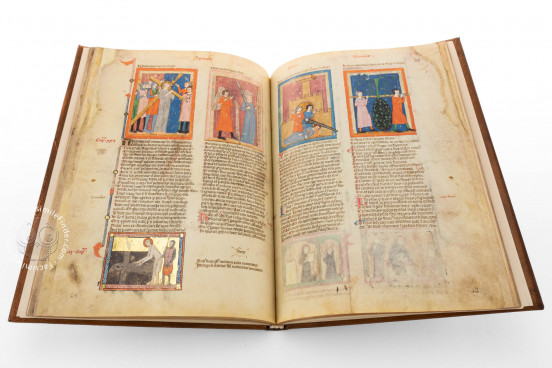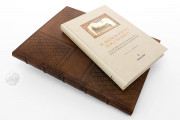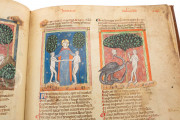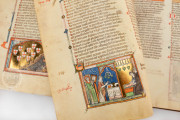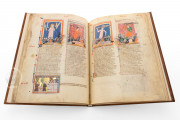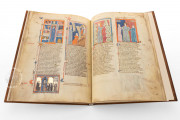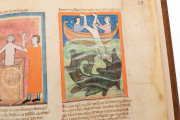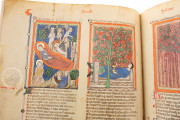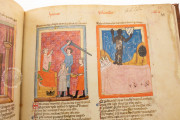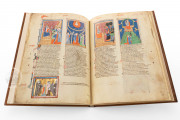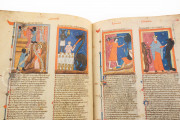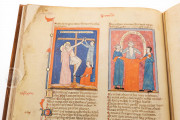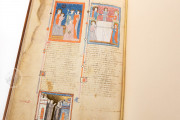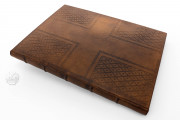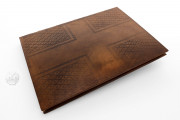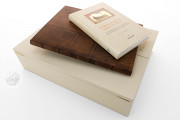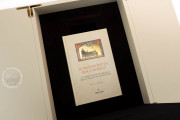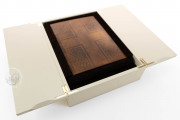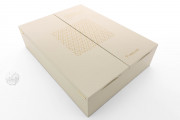Produced at Avignon around 1340, the Corsiniana Mirror of Human Salvation is an illuminated manuscript of an anonymous picture-book treatise that explains Christian history in terms of the typological understanding of the Bible. The Mirror was enhanced with a series of images in the bottom margins of some pages. These miniatures illustrate episodes in the life of Saint Francis and highlight correspondences between the lives of Francis and Christ. The manuscript's 227 miniatures constitute a uniquely Franciscan expression of salvation history.
Typology is the method of Christian biblical interpretation that understands Old Testament events and persons (types) as prefigurations of events described in the New Testament and from the early life of the Church. The Mirror of Human Salvation presents this understanding of salvation history in columns, each occupied by a picture at the top, followed by an explication of the pictured event's role in that history.
Three Artists, Complementary Messages
The miniatures of the Mirror are in French Gothic style, with simply drawn figures often engaged with others through forceful gestures. The patterned (or diapered) backgrounds are blue and/or rose. Gold leaf is used for halos and depicted objects of precious metal. Many of the figures are labeled, and speech is shown on banderoles. The illuminator's identity, Guillaume, is known from a pontifical in which he is named (Munich, Bayerische Staasbibliothek, Clm 10073). An Italian collaborator was responsible for the minor decoration.
The miniatures of episodes from the life of Saint Francis in the bas-de-pages were executed in the same workshop but are the work of another artist, one who made generous use of burnished gold for backgrounds. The segmented frames with geometric patterns of the Francis miniatures also differ from the monochrome frames of the Mirror miniatures.
Picturing the Franciscan Ideal
The Francis miniatures do not appear in chronological order but are placed to highlight parallels between the life of the saint and that of Christ, whose life Francis vowed to imitate. For example, a miniature of Saint Francis's famous re-creation of the scene of Christ's birth using real animals at Greccio in 1223 appears in the lower margin under the miniature of the Nativity of Christ of the Mirror (fol. 10v).
Text Designed for Four Columns
The core of the Mirror presents a series of events from the life of Christ and the early history of the Church, from the Annunciation to the Joachim to the Coronation of the Virgin, in chronological order. Each is grouped with three Old Testament types. These groupings of four determined the page layout of two columns per page, with each suite of four images and explanations on a pair of facing pages.
An Incomplete Survival
This core picture book is preceded by a prologue concerning the Fall of Humanity, accompanied by Genesis miniatures, and followed, in the Corsiniana manuscript as well as others, by texts and images addressing the seven stations of the cross, the seven sorrows of the Virgin, and the seven joys of the Virgin. The Corsiniana manuscript, however, is missing leaves at the beginning and the end and has other lacunae. The manuscript was acquired in 1786 by the Biblioteca Corsiniana as a part of the library of Nicola Rossi (1711-1785).
We have 1 facsimile edition of the manuscript "Corsiniana Mirror of Human Salvation": Storie di San Francesco facsimile edition, published by Istituto dell'Enciclopedia Italiana - Treccani, 2020
Request Info / Price
